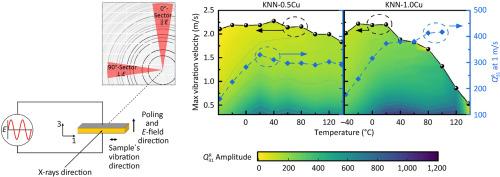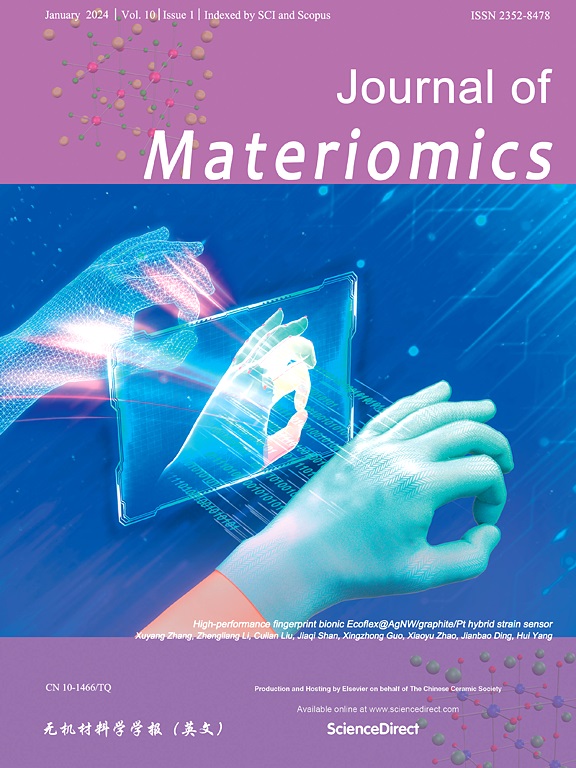K0.5Na0.5NbO3 压电陶瓷在大功率驱动下的铜硬化及其温度依赖性
IF 8.4
1区 材料科学
Q1 CHEMISTRY, PHYSICAL
引用次数: 0
摘要
本研究探讨了掺铜铌酸钠钾(KNN)压电陶瓷在高振速驱动下的电子机械性能与其结构起源之间的关系。在高功率共振条件下,通过原位高能 X 射线衍射对动态应变的内在和外在贡献进行了量化。这些贡献与观察到的次胁迫介电和压电响应相关联。由于非 180° 域的运动,掺铜会损害 KNN 的外在贡献,这与受体掺杂的硬质 PZT 相似,在 0.8 米/秒的速度下,非 180° 域壁运动产生的横向应变占总应变的比例降低了 5%。因此,掺铜 KNN 和 PZT 的性能相当。此外,还研究了不同掺铜量下机电性能的温度依赖性。此外,还研究了不同铜掺杂量的机电特性与温度的关系,特别是研究了在-40 °C至140 °C温度范围内,振动速度为1 m/s时的机械品质因数。研究结果表明,掺杂 0.5% 铜的成分在 1 米/秒的振动速度下表现稳定,在 20 °C 和 140 °C 之间机械品质因数的变化仅为 10%。本文章由计算机程序翻译,如有差异,请以英文原文为准。


Hardening of K0.5Na0.5NbO3 piezoceramics with Cu and the temperature dependence in high-power drive
This study investigates the relationship between the electro-mechanical properties of Cu-doped potassium sodium niobate (KNN) piezoceramics driven at high vibration velocities and their structural origins. Intrinsic and extrinsic contributions to the dynamic strain were quantified at high-power resonance conditions by in-situ high-energy X-ray diffraction. These contributions were correlated to the observed sub-coercive dielectric and piezoelectric responses. Cu doping impairs extrinsic contributions of KNN due to the movement of non–180° domains, akin to acceptor-doped hard PZT, reducing the fraction of transverse strain originating from non–180° domain wall motion over the total strain of 5% at 0.8 m/s. Therefore, the performance of Cu-doped KNN and PZT were found to be comparable. Both systems exhibit a high mechanical quality factor at low vibration velocity, which decreases at high displacement rates. Additionally, the temperature dependence of electromechanical properties for different Cu doping amounts was investigated. In particular, the mechanical quality factor at the vibration velocity of 1 m/s in a temperature range of −40 °C to 140 °C was studied. According to the findings, the composition doped with 0.5% Cu exhibited a stable vibration at 1 m/s, with only 10% variation in the mechanical quality factor between 20 °C and 140 °C.
求助全文
通过发布文献求助,成功后即可免费获取论文全文。
去求助
来源期刊

Journal of Materiomics
Materials Science-Metals and Alloys
CiteScore
14.30
自引率
6.40%
发文量
331
审稿时长
37 days
期刊介绍:
The Journal of Materiomics is a peer-reviewed open-access journal that aims to serve as a forum for the continuous dissemination of research within the field of materials science. It particularly emphasizes systematic studies on the relationships between composition, processing, structure, property, and performance of advanced materials. The journal is supported by the Chinese Ceramic Society and is indexed in SCIE and Scopus. It is commonly referred to as J Materiomics.
 求助内容:
求助内容: 应助结果提醒方式:
应助结果提醒方式:


